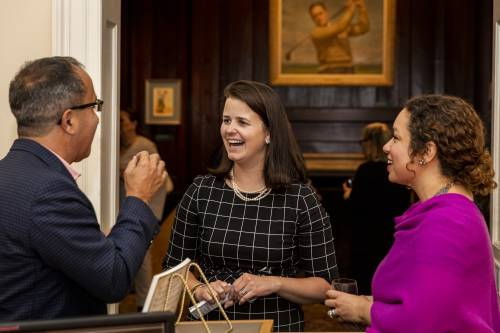On the Ball: Lake Forest Native Runs the Nation’s Oldest Sports Museum
- David A.F. Sweet
- May 4, 2021
- 3 min read
By David A. F. Sweet Only four years old, Hilary Cronheim’s love of art museums was already established. “I was the child who always had the audio guide at the museums,” she said. “I had no artistic skill -- none -- but I knew I wanted to be involved in art museums.”

“It combined my love of museums with my growing interest in golf," says Hilary Cronheim (center) about running the USGA Museum. Little surprise, then, that Cronheim – a Lake Forest native who graduated from Duke University armed with a master’s degree in art, art history and visual studies to complement her history of art bachelor’s degree from Cornell University -- runs a museum today. But there’s also a big surprise: no Renoirs or Turners hang on its walls. Rather, she oversees the masterpieces of Sarazen and Jones -- as in Gene Sarazen’s medals, Bobby Jones’ putter and much more. Cronheim is director at the nation’s oldest sports museum, the United States Golf Association Museum. No institution in the world has a larger role in the collection, preservation, interpretation and dissemination of golf history. The museum and library collections contain 750,000 photographs, 200,000 hours of footage and more than 100,000 library items in more than 25 languages. What spurred Cronheim – who worked for four years at The Art Institute of Chicago and spent one summer in Henry Clay Frick’s study among Rubens and Rembrandts at The Frick Collection in New York -- to choose to be involved with the sport of golf, which, as one best-selling author noted, at times is nothing more than a good walk spoiled? She moved close to the Liberty Corner, New Jersey museum eight or so years ago, and around the same time she started playing golf -- prompted no doubt by her husband David, who owns the Watchung Valley Golf Club. In 2015, a position for a librarian at the museum opened up. “I thought it would be a cool place to work,” Cronheim said. “It combined my love of museums with my growing interest in golf. And I thought the library job was a perfect fit since I've worked in archives my whole life.” At one point, she labored on a project all golfers are familiar with: the often-inscrutable rules. Their modernization took effect last year. “Rules modernization was a frustrating thing because the rules are so hard to get your head around,” she said, “but when it was done, I was so proud to have played a small role.”
Then, in 2019, Cronheim was tapped to lead the entire museum. Two months later, she shared USGA artifacts during a reunion of more than 30 U.S. Open winners before the tournament at Pebble Beach. “That was one of the greatest moments of my career,” said The Lawrenceville School graduate, who showed the pros items such as Francis Ouimet’s 1913 U.S. Open-winning putter and Ben Hogan’s one iron from the 1950 U.S. Open. “Some of them were amazed at what the USGA has. It became obvious to me that there's tremendous interest in artifacts.” Upended by the pandemic in 2020, when it was forced to close in March, Cronheim has needed to adapt. The museum now posts more frequently on Facebook, discussing the hobbies of golfers along with other topics. Cronheim and her team brought renewed focus to a website revamp, knowing that it is important for fans to access the museum virtually if they can’t show up physically. "Like a lot of museums, we have a lot of stories to tell but not the space to tell them,” said Cronheim, who noted only about 5 percent of the USGA Museum’s artifacts are on display. “We have to think of creative ways to share the collection with the public without having them come to Liberty Corner.” Most notably, last July the USGA Museum purchased the Howard Schickler Photo Collection. Given more than 1,000 golf-related photos comprise the collection dating as far back as the 1850s – before the game was even played in the United States – it’s one of the museum’s top acquisitions in its 84-year history. “It could be in The Art Institute without question,” Cronheim said. “He's a fine-arts photographer. The images he collected wouldn't get the typical trophy shot – he’d get the more candid shot.”
Though one might think the USGA team members under her employ are golf fanatics, some barely play the game.
“We are museum professionals before we're golfers,” she said. “We have an interest in preserving cultural experience, of which golf is part, to learn about American history.”
This article was reprinted with the permission of Classic Chicago magazine. Read more of its articles at classicchicagomagazine.com.





